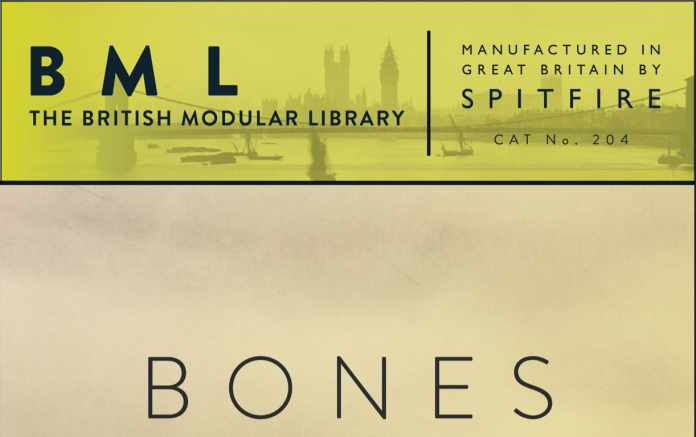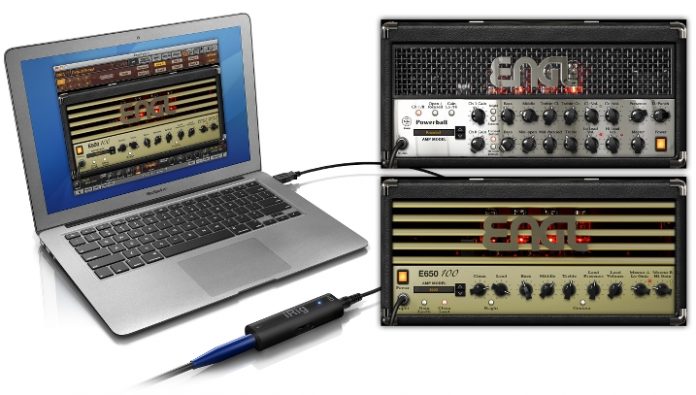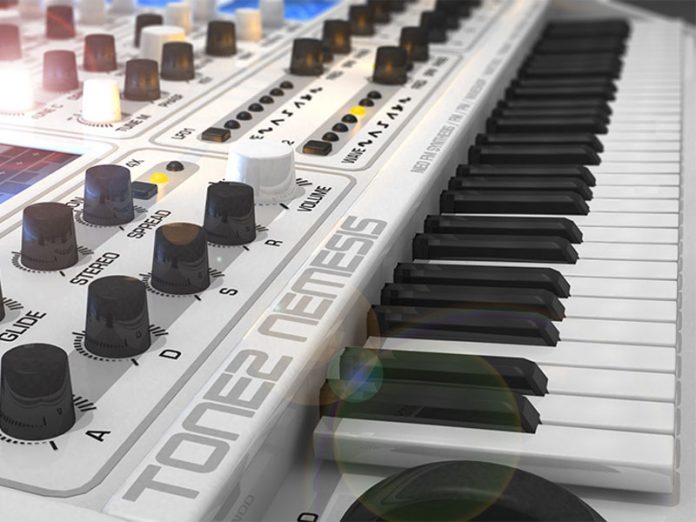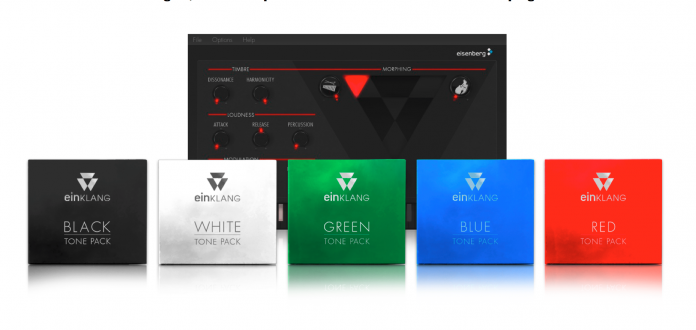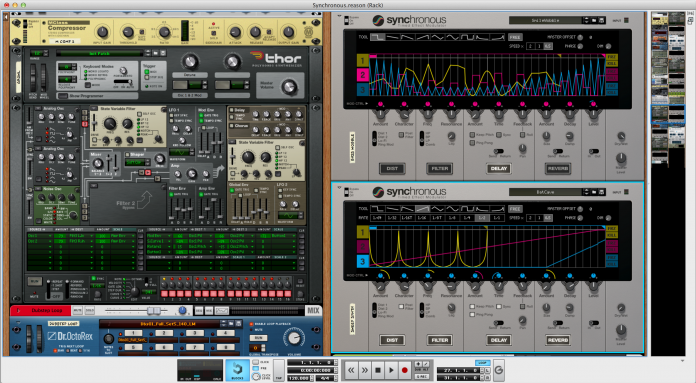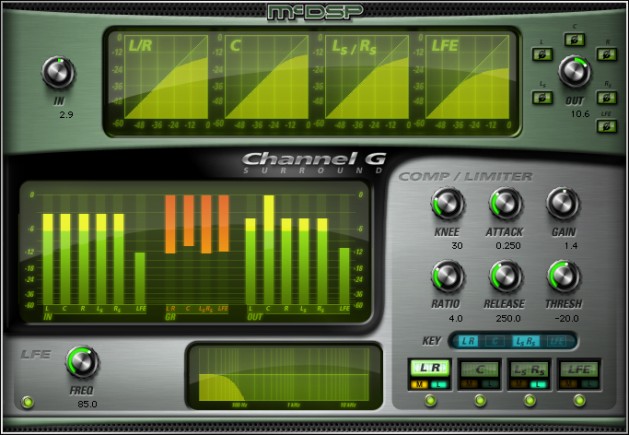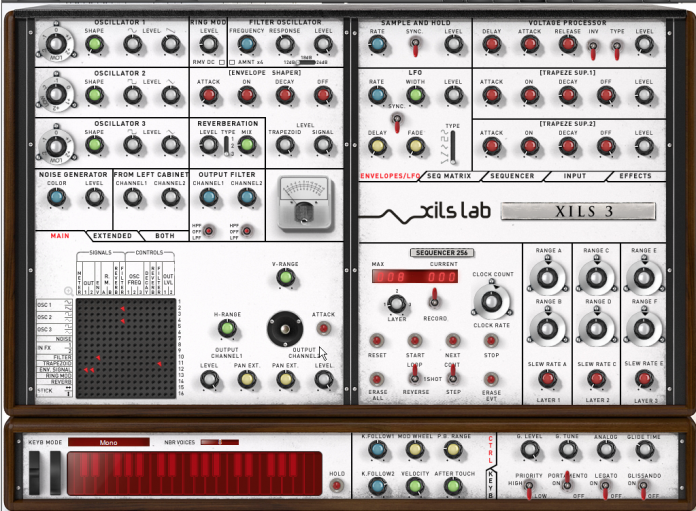AMSTERDAM, The Netherlands, April 14, 2014: FabFilter is celebrating its tenth anniversary of creating powerful audio plug-ins with superb sound quality and innovative interfaces. The company is proud to toast this occasion by announcing a generous ten-day sale, with a discount of 40% off all bundles and plug-ins, from April 14 to 24: www.fabfilter.com/shop. In addition, FabFilter will make a charitable donation to Stichting MEMO, a local organization bringing children in their early years in contact with young professional musicians and their passion for making music.Ten years ago, FabFilter released its first plug-in, FabFilter One, a basic but powerful synthesizer, promising exceptional sound quality and an eye for detail in both audio processing and design. That promise still holds true today, and the dedication to superb signal processing and well-designed, modern user interfaces and workflow remains undiminished.FabFilter One and its Volcano followup ultimately led to the Creative plug-in range, with FabFilter Saturn being the latest addition. Renowned for their unique drag-and-drop modulation system and smart interface design showing only the components that are actually being used, all Creative plug-ins positively succeed in balancing a huge range of inspiring possibilities with enviable ease of use.With the release of the high-quality compressor plug-in Pro-C in 2007, FabFilter laid the foundations for the ongoing Pro series, highly regarded for their high-quality transparent sound, beautiful interfaces, and well-thought-through workflow. Co-founder Frederik Slijkerman: “FabFilter Pro-Q, our EQ plug-in, is one of our absolute bestsellers and still one of the best examples of what FabFilter is all about: beautiful sound, fantastic workflow! We were really able to realize our vision of power converging with simplicity and elegance.”Coming full circle, fellow FabFilter co-founder Floris Klinkert claims, “FabFilter Pro-MB is really a result of the 10 years we’ve now been working on audio plug-ins. It combines advanced dynamics algorithms with a forward-thinking, modern interface, rethinking the concept of multi-band processing.”Such sentiments are far from lost on FabFilter’s lengthy list of equally enthusiastic professional users. To quote a few:“All of the FabFilter plug-ins seem to be designed to be simple to use and easy to get great results with while sounding incredible.”– Tony Maserati (Grammy® award-winning mix/recording engineer and producer for Lady Gaga, Beyoncé, Mariah Carey)“I’ve known Floris for a very long time. We even did some tracks together in the past! When I heard he was involved in making his own plug-ins, I was immediately interested and have followed him ever since. It’s fantastic to see the company being so successful today.”– Armin van Buuren (five times #1 DJ in DJ Magazine’s Top 100)“I first learned about FabFilter plug-ins from engineer and friend Dave Pensado. After checking them out for myself, I just had to have them in my mixing toolbox. I love the uniqueness and stellar quality they have. I recommend FabFilter as ‘must-have’ plug-ins for anyone who is a serious mixing professional.”– Khalig Glover (Grammy® award-winning engineer/writer/producer for Prince, Michael Jackson, Justin Timberlake, Angie Stone)“FabFilter Pro-Q and Pro-C are so intuitive and versatile, and the sound is manipulated so eloquently and smoothly, that they have moved to the top of the list of plug-ins I reach for most often!”– John Jaszcz (Grammy® award-winning engineer/mixer for Kirk Franklin, John Michael Montgomery, Bootsy Collins)
FabFilter Turns 10
Spitfire Audio: Bones Vol 1
Look out EastWest, you’ve got a new contender on the sample libraries. British virtual instrument developer Apritfire audio has added trombones to the mix in Bones Vol. 1
LONDON, UK: compositional tools creator Spitfire Audio is proud to announce availability of BONES Vol. 1 — adding trombones to the ultimate detailed brass collection as part of its BML (British Modular Library), a longterm project to create the greatest-sounding, deepest sampled, and ultimately future-proofed living orchestral virtual instruments collection on the planet — as of March 1…
Following in the fabulous footsteps of HORN SECTION Vol. 1 (featuring essential articulations for both solo horn and horns a2 — a2 meaning two players on each) and LOW BRASS (tuba, contrabass trombone, cimbasso, and cimbasso a2), BONES Vol. 1 represents the eighth instalment in the ongoing BML series of virtual instruments for Mac (OS X 10.6 or higher) and PC (Windows 7) with its essential articulations for trombone allowing composers to add further fine detail, musical expression, beauty, and focus to their work.
As working award-winning composers themselves, the collective that is Spitfire Audio appreciate what it takes to make world-class film, TV, and games music. As such, BONES Vol. 1 is a carefully curated selection of articulations from two trombone sections — Tenor Trombones a2 and Bass Trombones a2 — to provide everything needed to compose great music for a brass section. As implied by name, future volumes will follow, featuring soloists to provide three different players of each size on different instruments in different positions when played tutti (together). Of course, creating the greatest-sounding, deepest sampled, and ultimately future-proofed living orchestral virtual instruments collection on the planet takes time. Rome wasn’t built in a day, after all!
London is where it’s at here, however. In keeping with the rest of Spitfire Audio’s acclaimed BML range, BONES Vol. 1 features the best musicians working in London today, playing rarefied and priceless instruments; indeed, The English Session Orchestra comprises the finest session musicians, all of whom have played on the majority of A-list film scores recorded there as part of a healthy mix of seasoned session players interspersed with international soloists, high-profile chamber musicians, and emerging young talent. To that end, producer/engineer extraordinaire Jake Jackson has been charged with recording BML at Air Studios in Hampstead, one of the finest recording studios in the world and host to many fine film scores, including Gladiator, Harry Potter, and James Bond, as well as countless top-selling classical recordings. A selection of rarefied microphones fed via Neve ‘AIR Montserrat’ preamps through the world’s largest Neve 88R console onto a finely maintained Studer two-inch tape machine — making BML the only orchestral sample library on the market to be firstly recorded to tape — then finally to 24-bit/96kHz digital audio via high-end Prism AD convertors combine to produce a great sound.
Yet the BONES Vol. 1 success story does not simply stop there. There’s so much more to making great-sounding samples from those great- sounding recordings than might first meet the eye — or even ear! Firstly, all the talented players involved were rigorously recorded in situ and meticulously mixed with precise perspective and placing to lock together with each and every BML module as if they were all in the same room when recording. Why? Well, when you start putting sections together, it simply works — no mixing, panning, or careful manipulation of reverbs required!
Deeper still, recorded deeply with up to eight-round robins and numerous dynamic layers and controls, BONES Vol. 1 also features many scripting and sampling innovations developed when producing the seminal SABLE volumes and MURAL string ranges for BML. It comes complete with the same intuitive GUI and full feature set, such as a comprehensive selection of microphone perspectives, plus time- and effort-saving measures courtesy of Jake Jackson’s masterful mixes. Moreover, additional expression features, including intensity, tightness, and control of release triggers, serve to provide BONES Vol. 1 with even more human-like elements and abilities to tweak the sounds to any user’s heart’s content. According to Spitfire Audio co-founder Paul Thomson, “You’ve got the full monty — the full range — there. It’s exciting for us to hear the whole thing coming together.”
All told, then, BONES Vol. 1 really represents an exciting ready to play straight out the box experience for creating ultra-realistic, true- sounding mockups, demos, and masters. Music is really where it’s at, then. Thanks to BONES Vol. 1, composing great music for a brass section has never been easier or sounded better from a virtual instrument perspective. To try is to buy!
For more detailed info and an awe-inspiring audio demo please visit the BONES Vol. 1 webpage here: http://www.spitfireaudio.com/bml-204-bones-volume-1
Watch Spitfire Audio co-founder Paul Thomson’s telling BONES Vol. 1 video walkthrough here: https://www.youtube.com/watch?v=vfWkNIoN6-4
IK Multimedia ENGL for Amplitube
ENGL makes some killer amps with loads of gain. Now IK Multimedia has added more high gain edginess to the Amplitube store. They have added the ENGL E650, Powerball, and 2 4X12 cabs.
ENGL E650
The E650 all-tube amp head is an ENGL signature model that brings an incredible range of rhythm and high-gain lead tones from a dual mode amp. It delivers a vast array of tones from sparkling clean to bone-crunching distortion, and everything in between thanks to its two switchable channels with different gain ranges, a shared EQ section and a contour button that boosts the mid-frequency range between 200 and 500k, and bright switches for boosting the upper treble range. The ENGL E650 conjures up classic rock-god tones from the 80s and 90s as well as heavy crunch and distortion for tomorrow’s tone connoisseurs.
ENGL Powerball
The ENGL Powerball model is based on one of the most powerful modern high-gain amplifiers. It is highly regarded for heavy rhythm tones and its many sound-sculpting options. The Powerball model has two main channels, and then each channel has two different modes. Channel I offers “Clean” and “Crunch”, and Channel II has “Low Lead” and “High Lead”. It has the power and flexibility to create everything from modern super high-gain leads to heavy crunch rhythms to ultra-clear clean tones.
ENGL Cabinets
The new AmpliTube CS release also features two matched ENGL speaker cabinets: the E412 Standard and the E412 Pro XXL. These perfect companion cabinets are capable of rendering the complex harmonic structure, razor sharp attack and massive low end thump of the amplifiers at their best, without losing anything in the midrange frequencies.
AmpliTube Custom Shop
The AmpliTube Custom Shop for Mac/PC is a free DAW plug-in and standalone app that gives players access to some of the most sought-after analog and digital music gear. Once installed, it allows players to browse collections of gear models from the world’s top manufacturers of gear including Fender®, Ampeg®, Orange®, Soldano®, Seymour Duncan®, Jet City®, Gallien-Krueger® and more, plus signature gear from artists like Slash and the late Jimi Hendrix. Players can buy individual pieces of gear using Custom Shop gear credits or entire collections with gear credits or currency.
Plugging In
With IK Multimedia’s range of interfaces for mobile devices and Mac/PC, getting guitar signal to AmpliTube is as simple as plugging into an amplifier. iRig HD and iRig PRO are the newest digital interfaces that allow players to plug into an iPhone, iPad, iPod touch and a Mac or PC* and delivers pristine quality pure guitar signal.
*Support using the ASIO4ALL driver on Windows® XP, Vista, 7 or 8.
Pricing & Availability
To access the new gear models in the AmpliTube Custom Shop, users need to download AmpliTube version 3.12, which is also a free update for current AmpliTube owners, and is available for Mac/PC. The gear models in the Custom Shop are sold using Gear Credits and are priced between 5 and 30 credits each. Gear Credit Packs start as low as $19.99/€15.99 (for 20 credits) and go up to $749.99/€639.99* (for 1,500 credits).
Review: Tone2 Nemesis
FM Synthesis is a very powerful tool for sound design, but if you don’t have a firm grasp on the principles, you will quickly find yourself very frustrated with the ratio of effort to results. Add on the sound quality of many FM style soft synths and you will find yourself with thin, laser beam sounding presets and too many controls, leaving you cursing the fact that you even got into this FM mess in the first place.
That was me about a month and a half ago. I was very eager to master FM synthesis but the initial payoff and sound quality burned me out quickly. Then Tone2 released Nemesis, their answer to the current state of software synthesis. Nemesis features the traditional FM type synthesis but also adds their own spin with what they call “NeoFM Synthesis.” I’ve had experience with Tone2 (Saurus Review Here) and figured if anyone can make this easy, it will be these guys. I was not let down. The interface was very familiar, taking the guesswork out of what function does what. Each section of the interface is laid out in a very straightforward fashion, giving you quick access to the controls you need right when you need them.
Nemesis takes a very head on approach to FM synthesis, offering a true to life rendition of the classic analog FM synths, but with a Tone2 twist. If you’re looking for diversity and options, you’ve come to the right place. Nemesis offers at least 22 different types of combinable synthesis, some even exclusive just to Tone2. The possibilities go for miles. Add on an easy to use but extremely powerful Gate, Arpeggio, and 33 different types of effects and you have just about every possible scenario you would need covered. The best part of this synth is the ease of use and fast access to all controls. You will see very quickly when learning FM Synthesis sound design that there are a lot of factors and controls needed and having an organized layout is key. Nemesis is broken down into easy to use sections that lay out the signal flow nicely. Everything is clickable with drop down menus at your disposal for spectral editing as well as sequencing your patches. I do have one complaint about the layout and that is each preset doesn’t have text, telling you which type of synthesis you are using for any given patch. This would be beneficial to newcomers learning how to create sounds as well as people with horrible memory, such as myself. Other than that and a quick read through their 80-page manual, you have a very solid setup.
For the person who doesn’t necessarily want to get that in depth with the program, Nemesis features 1000 user patches that meld very nicely into your tracks. I found the presets to be unique in sound but not overbearing to the point that it sticks out like a sore thumb. Unlike other FM synths I have tried out in the past, I do not get that whiney harsh tone you usually get out of most FMs. On the other side, if you do run into a harsh preset, you can very easily incorporate the “boost” section of the configuration display and incorporate different types of filters as well as cuts. This gives you the option for a cold digital sound or a warm analog sound. Versatility is key and behind the simple-to-use interface lies a very complex beast that is very easily tamed.
For the sound design type that wants complete control, you could not have a better synth. Even those with a desire to learn can easily master sound design with each section subdivided and feeding the next. Routing is a breeze and the amount of options given are staggering. You can even import your own WAV files to incorporate into the synthesis. A few clicks around the GUI and you’re off to creating your very own sounds. I found myself starting off with a preset to jump from and slowly editing parts to taste. I found the spectral editor to be a massively useful tool in creating subtle movement in my presets. Tone2 has even given you presets for fast access or assistance in your sound design endeavors. Need more movement than that? Simply move to the configuration menu in the bottom left and you are left with countless choices of effects, gates, chord, and arpeggiated goodness to breathe life into your presets. I could list all of the options in this review but it would take up too much space. Plus you’re already chomping at the bit to download it anyways.
So what is there not to like? Not a lot. I hate that I can’t use this synth in Pro Tools due to no AAX and have found that in Maschine, my patches never load up properly, but this was an issue in Saurus, I’ve found as well. Something is very odd about the save state and I would prefer when I click “Save-as”, it saves locally to the program and not to the hard drive. All I recommend is save your presets often. Other than those small issues and the fact that there is no way to see which synthesis type you are currently using (a check mark or anything will do), I’d say this synth is a no brainer. Nemesis is actually very easy on resources too, seeing as I’ve run countless tracks without it bogging down my CPU in the least. Boredom is never an issue with any Tone2 product due to the constant sound packs that are released. Since its release not too long ago, Tone2 has already released 3 packs that push the envelope of what this program can do.
I actually highly recommend Nemesis for just about any EDM or even pop producer at any level. I’m sold simply on the quality of presets and functionality in a visually appealing package. Nemesis requires very little processing in mixes and has actually caused me to reach for it a little more, causing it to slowly creep into my “go-to” category. Coming in at 200$, given the amount of control and sound quality, I’d say it’s a steal.
To Buy, click HERE
For more info, Visit http://www.tone2.com/html/nemesis_synthesizer__vst_au.html
Eisenberg Einklang Extended
From what I can understand based on this press release, Eisenberg’s Einklang Extended is similar to what is available in Avid’s Xpand plugin allowing you to combine different types of synthesis in layers to make unique sounds in a way that is easy for the user who doesn’t necessarily want to dig too deep into sound design. Each pack for Extended is based on a certain color and serves specific purposes. This is an extremely interesting synth. I may have to try it out.
Audio company Eisenberg is proud to announce availability of EINKLANG Extended — bundling its exceptional EINKLANG software synthesizer for Mac (OS 10.6 or higher) and PC (Windows XP or later) with its RED Tone Pack, GREEN Tone Pack, and BLUE Tone Pack, plus the recently-released premium WHITE Tone Pack and BLACK Tone Pack, to add a whole new range of tone colours — as of March 20…
Eisenberg’s EINKLANG is a soft synth like no other. After all, a dictionary defines a synthesizer — somewhat simplistically — as an electronic musical instrument that produces a wide variety of sounds by generating and combining signals of different frequencies. Whereas synthesizers traditionally do this according to a strict set of technical parameters, EINKLANG resynthesizes sounds using instrument models based on Eisenberg’s Artificial Intelligence Studio Technology (AIST), allowing it to understand the structures of sounds and remember specific nuances of different instruments so you don’t have to. Lowering the pitch of a cello affects its timbre in a different way to lowering the pitch of a french horn, for example — just like their real-world counterparts. Conversely, you can even detune a single string from a cello — detuning its overtones, in other words, which is physically impossible for monophonic one-dimensional resonators such as a single string. Clever stuff!
Similarly, those instrument models can be tweaked directly using the minimal TIMBRE, LOUDNESS, and MODULATION musical parameter groups — all of which affect the sound more deeply than might first appear possible, thanks to that powerful AIST engine. Elsewhere, instrument models are also morphed seamlessly from one sound to another using the MORPHING triangle with three slots for tone colours. Cleverly, EINKLANG is the first synthesizer to introduce a strong synaesthetic link between sound and colour with all GUI controls responding to MORPHING triangle relationships in corresponding colours — just like white light is able to travel through the colour spectrum in additive colour synthesis. Morph three tone colours together as one and everything is illuminated in pure white. It’s all in einklang (agreement). As a result, musicians can concentrate on doing what they do best — making musical sounds, without having to first familiarise themselves with overwhelming technology.
EINKLANG itself comes complete with 150 tone colours for morphing purposes, ranging from acoustic to synthetic. But by bundling it with RED Tone Pack, GREEN Tone Pack, and BLUE Tone Pack, plus the recently-released premium WHITE Tone Pack and BLACK Tone Pack, Eisenberg has considerably extended its sonic reach — so much so that it’s almost like playing a completely new EINKLANG each time!
RED Tone Pack, GREEN Tone Pack, and BLUE Tone Pack effectively belong together as they capably cover a third of the common tone colours between them: RED Tone Pack provides 120 synth/lead tone colours, including a variety of classic synth basses and pleasing pads — smoothly morph from an analogue-sounding lead to a shimmering-sounding pad to a screaming-sounding bass and discover numerous new sounds in-between; GREEN Tone Pack presents 120 acoustic/live tone colours, including pads, acoustic and electric pianos, various organs, synth and acoustic basses, brass, guitars, and vocal/choir sounds — all of which can be morphed with each other or other tone colours; and BLUE Tone Pack proffers pads in profusion — 120 drone/pad tone colours, to be precise, all of which create movement within themselves or any other tone colour that they are combined with. Whatever your personal preference, each offer more MODULATION over time and a stronger dynamics component compared to the standard 150 tone colours included in EINKLANG alone.
WHITE Tone Pack and BLACK Tone Pack possess an even wider range of dynamics and intra-morphing, meaning a tone could be a piano in the lower range and a marimba in the higher range or even a trumpet when played with more dynamics, for instance. In building both of these packs, Eisenberg analysed three times more content than was the case when creating their colourful siblings — hence the premium appellation. As such, WHITE Tone Pack puts forward 120 energetic/uplifting premium tone colours, making much use of useful splits, such as different basses in the lower register and a selection of sounds such as organs, electric pianos, and pads in the upper register, while BLACK Tone Pack presents 120 dark/ambient premium tone colours, including lots of touch-sensitive basses, leads, pads, and organs, as well as sounds specially designed to add certain frequencies or qualities to enhance a set of two other tone colours — ‘stringify’ sounds or sprinkle a little ‘stardust’ over the top, so-to-speak.
With sizeable savings — compared to purchasing everything separately, surely everyone will be in complete agreement: EINKLANG Extended represents remarkable value. Quite simply, sound design heaven speedily awaits anyone willing to take the plunge into the truly groundbreaking world of AIST-assisted sound generation. Generally speaking, what takes dozens of knobs to achieve using conventional synthesizers can be done with one in EINKLANG. Exactly what’s not to like? We’re sure you’ll like what you hear — morphing or otherwise!
Available in AAX, AU, RTAS, VST
Check out some awe-inspiring audio examples of EINKLANG in action here: https://soundcloud.com/eisenbergaudio/
All set for an April release, EINKLANG 1.2 is improved with several new features: reworked playback engine with louder main output, visual level meter with fine control for volume gain, and a new preset browser in both standalone and plug-in modes.
Reason 7.1 Update and New Rack Extension
Given that Propellerhead announced a new SDK to make porting manufacturer’s plugins over to rack extensions more easily, a new version of Reason has been released. To encourage users to update, Propellerhead has announced a new free rack extension, Synchronous, a swiss army knife for rhythm based effects to tracks. I respect that Propellerhead has kept integrity by keeping the user experience close to the chest, I just hate having to buy the same plugins I own again. I think in the end, it doesn’t necessarily hinder the use of Reason, it just changes the industry’s application.
Propellerhead today released an update to their award-winning Reason software and Synchronous; a modulation Rack Extension plug-in for Reason.
Reason 7.1 offers an enhanced workflow, performance improvements and new SDK2 technology for Propellerhead’s Rack Extension plug-in platform.
Since its release in 2012, Propellerhead’s Rack Extension platform has emerged as a powerful audio plug-in format currently with over 600 companies developing and over 200 instrument and effects devices available via Propellerhead’s online store. Rack Extensions blend seamlessly in the Reason rack offering great sound, smooth workflow, rock-solid stability, intuitive routing, automation, deep-editing and flexibility Reason users expect.
About Synchronous—Timed Effect Modulator
Highlighting new interactive graphic capabilities of the SDK2 technology, Synchronous is a Rack Extension plug-in for Reason that offers rhythmically synced effects that bring your music to life. With a dynamic and intuitive graphic user interface and the ability to instantly recall over 100 patches, Synchronous is incredibly flexible. With the built-in waveform tools, users can easily draw and dial in Distortion, Filter, Reverb, Delay and level for anything from side-chain pumping and tremolos to beat-repeating and tweaked out wobbles.
Pricing and Availability
Reason 7.1 is a free downloadable update for all Reason 7 owners. Existing Reason upgrade pricing remain the same at $129 USD / €129 EUR.
For more information, visit www.propellerheads.se
Synchronous is available for free for all Reason 7.1 customers up until June 30, 2014.
Waves Vitamin
Waves Audio announces the availability of Vitamin Sonic Enhancer, a multiband harmonic enhancer and tone-shaping plugin that can make any track sound powerful and full of spark by mixing an enriched version with the original signal. With its zero-latency processing, Vitamin caters to studio and live mix engineers alike. Used as an insert on any track or bus, Vitamin instantly delivers a warm, vital result that is comparable to what users would get from a parallel chain of EQ, compression and saturation processors, but without the hassle.Vitamin’s controls are intuitive, easy to use and immediately responsive, letting users smooth or accentuate punchiness and dynamics, determine the crossover frequency points between the plugin’s five bands, and control the mix of the direct signal with its enhanced version. To top it all off, when Vitamin is in stereo mode, each band has a width control that lets users create wider sound images or make room for a vocal right in front of the mix – a great tool for mastering.No matter what it is used on, Vitamin opens up the sound in a way that complements and enhances all mixes, ensuring they get all the nutrients they need.Vitamin Sonic Enhancer Features:
- Parallel multiband harmonic enhancer with five individual bands
- Control over the crossover frequency points between bands
- Control over the mix of the direct signal with the enhanced version
- Per-band stereo width control
- Punch control for smoothing or accentuating punchiness and dynamics
- Zero-latency processing
McDSP Channel G Surround in AAX
Need Channel G for Surround sound mixing in Pro Tools 10 or 11 in AAX-64? You’re in luck, It’s here!
McDSP is proud to announce the release of Channel G Surround for Pro Tools 10 and 11 with support for both Mac and Windows, in AAX DSP and AAX Native plug-in formats. Channel G Surround, like all McDSP AAX plug-ins, includes a 64-bit audio path, real-time control smoothing, and operation above 0 dB. The AAX DSP version can also share dsp chips with other AAX DSP plug-ins on Avid HDX hardware.
McDSP customers already owning the v5 version of Channel G Surround can download this update free of charge. Customers not owning Channel G Surround v5 can upgrade their plug-in at McDSP’s web store, or through their local Pro Tools dealer.
Please visit www.mcdsp.com for more information.
XILS-lab 3 EMS VCS3 V.2 Update
GRENOBLE, FRANCE: music software company XILS-lab is proud to announce availability of XILS 3 V2.0 — an updated version of its authentic-sounding software emulation of the groundbreaking late-Sixties-vintage EMS VCS3 portable analogue synthesizer, scaled up to also emulate EMS’ early-Seventies-vintage Synthi Sequencer 256 — as of April 7…The British-built EMS VCS3 — or Electronic Music Studios Voltage Controlled Studio #3 to give it its full appellation (also affectionately known as ‘The Putney’ — after company founder Peter Zinovieff’s original pioneering electronic music studio location in the leafy London suburb — and, somewhat confusingly, ‘The Synthi’ — after its later SYNTHI VCS3 II incarnation) — made musical history upon its 1969 introduction as the first commercially portable synthesizer available anywhere in the world. Its innovative modular matrix-based patchboard dispensed with the telephone exchange-like cabling of other (much larger) modular systems in favour of making connections with (removable) coloured pins, so it could be comfortably housed in a small wooden (solid afrormosia) cabinet. Distinctive in both its physics laboratory test equipment-lookalike looks and strange-sounding sound effects, the VCS3 quickly found favour with the more experimental leading lights of the day, including the BBC Radiophonic Workshop (think Dr Who), Brian Eno (with Roxy Music), Jean-Michel Jarre, and Pink Floyd, to name but a few first-generation famous users, before being effectively killed off by a wave of powerful programmable American analogue polysynths and the more mainstream (and affordable) digital developments that ultimately changed music making forever.But what goes around comes around. Today those strange sounds are sought after again and new VCS3s are available to order from a former EMS employee — at a premium price tag with an accompanying long wait, while XILS-lab’s cost conscious and award-winning XILS 3 software emulation for Mac (OS X 10.4 and above) and PC (Windows 7, Vista, and XP) proved popular with both first-time buyers beginning a wonderfully in-depth journey into the wonderful world of modular synthesis and also seasoned synth explorers, including renowned sound designer Richard Devine and original VCS3 aficionado Tim Blake (Hawkwind), as well as Peter Zinovieff himself, who commented kindly: “A great step forward!”Time stands still for no one or no thing, however. Nowhere is this more apparent than in the here today, gone tomorrow world of music software. So what’s new in XILS 3 V2.0 for Mac (OS X 10.5 and above) and PC (Windows 8, 7, Vista, and XP) from XILS-lab, then? The attractive, all-new GUI is clear for all to see from the outset. But beauty is not only skin deep in this ergonomically-enhanced case. It’s as easy to use as it is easy on the eye with workflow improvements in abundance. Users can now zoom in on all matrices, for example, while continuous modulation amount is now possible within the pin matrix itself — with advanced ‘swivelling’ pins providing so much more than eye candy (though they do look lovely)!Likewise, polyphonic sequencer workflow is radically improved in the SEQUENCER 256 module, inspired by EMS’ trailblazing Synthi Sequencer 256 namesake. Needless to say, this three-layer sequencer with analogue-to-digital and digital-to-analogue converters to enable digital processing of control voltages to drive multiple analogue synthesizers or multiple parameters with storage of up to 256 ‘events’ was well ahead of its time when released in 1971. Here in the virtual world, XILS-lab has well and truly transported it to the present day with three independent layers, slew rates, and recording modes, together with added abilities like sequencer layers acting as modulation sources in a dedicated SEQ MATRIX — matchless, even by today’s most sophisticated DAW standards!So is that all? No, not at all! Adding a second matrix with two additional envelopes, an LFO, comprehensive SAMPLE AND HOLD module, and VOLTAGE PROCESSOR, plus several new input modules — including GATE, ENVELOPE FOLLOWER, and PITCH TRACKER — means that there are hundreds of additional connections available to the discerning synthesist set on exploring XILS 3 V2.0 to the full as a superlative soft synth or as a powerful effects processor plug-in in its own right. In fact, there are over 800 different connections per patch with ‘only’ 583 simultaneous connections to boot… but who’s counting, anyway! Add a gorgeous 18dB filter emulation alongside a three-mode analogue chorus, delay, and phaser, plus much more besides, and what have you got? A truly ‘21st Century VCS3’ that is, indeed, a great step forward, that’s what! What’s more, 150 new presets and an improved (retagged) factory bank makes for a more meaningful starting point for your own modular journeying, wherever it may take you.Whatever way you look at it, plumbing the depths of XILS 3 V2.0 could take several lifetimes. Literally, time stands still for no synthesist, sadly, so why not make the best use of whatever sound-sculpting time you have by exploring XILS 3 V2.0 to see and hear what it can bring to your own compositions? Certainly the pioneering Peter Zinovieff would wholeheartedly approve!
XILS 3 V2.0 is available to purchase as an eLicenser or iLok copy-protected virtual instrument and effects plug-in for an introductory discounted price of €120.00 EUR (rising to €149.00 EUR on May 1, 2014) from the XILS-lab web store here: http://www.xils-lab.com/pages/STORE.html (Note that this time-limited offer also includes the XILISTICS sound bank for XILS 3 with 160-plus presets worth €25.00 EUR, equalling an overall saving of €54.00 EUR!)
XILS 3 V2.0 can be directly downloaded as a 32- and 64-bit-compatible virtual instrument and effects plug-in for Mac (AAX, AU, RTAS, VST) and Windows (AAX, RTAS, VST) from here: http://www.xils-lab.com/pages/XILS32_Download.html
Check out several informative XILS 3 V2.0 tutorial videos here: http://www.xils-lab.com/pages/XILS32_Videos.html
McDSP Reason Rack Extensions
Fear not Reason users! Colin McDowell has not forgotten about you and has ported over several new Rack Extensions for the Reason store. They range from classic emulations to modern versions of EQs from their Ultimate EQ series. Let’s hope to see their flagship Filter-bank. You can get the bundle for 119$ or each for 49$. Not a bad deal for one of the top plugin manufactures.
McDSP is proud to announce the release of three new equalizers for Reason Rack Extensions. Choose from three uniquely and meticulously hand-crafted equalizers to add that warmth and presence that your music has been waiting for. Offered at just $49 a piece, there is the E670, Moo Q, and FRG-EEE, or purchase them all for just $119, in the Equalizer Collection bundle.
E670
The E670 Rack Extension plug-in is a three-band equalizer with a flexible design and vintage tone. An excellent companion product to the C670 compressor.
The E670, like the C670 compressor, is ideal for master buss tracks and instrument groups. Gentle equalization curves impart just the right amount of tone tweak. Vintage output staging colors tracks nicely, without muddying up your mix. Real-time control smoothing gives it an analog gear feel. And it sounds awesome.
The E670. E is for awesome.
Moo Q
The Moo Q Rack Extension plug-in is a software emulation of modern tube-based equalizers. The Moo Q goes with audio tracks like milk goes with cookies. Get some Moo in your music with the Moo Q equalizer.
Fatten up your tracks with the Moo Q Rack Extension equalizer plug-in. The Moo Q smooth equalization curves will bring out the sonic subtleties you’re looking for in a moo-sical three-band configuration. Bring on the bass. Milk the mid-range. Shine up that top end. And there’s no cow tipping here – you can’t make the Moo Q sound bad, because it’s that good.
The Moo Q equalizer. Milk your tracks for all they’re worth. Cookies not included.
FRG-EEE
The FRG-EEE Rack Extension plug-in is a modern four-band equalizer consisting of low and high shelving EQ wrapped around two parametric bands.
The FRG-EEE equalizer (aka ‘froggy’) packs a punch at the low and high end using a shelving EQ technique we call frequency resonant gain (FRG). This approach gives the FRG-EEE a little extra near the selected shelving frequency for, well, a little extra. The two parametric bands have a reasonably tight (but musical) Q, and wide frequency ranges.
The FRG-EEE. Now it’s easy to be green.
Price: $49.00 a piece of $119.00 for the bundle
Please visit www.mcdsp.com for more information.




